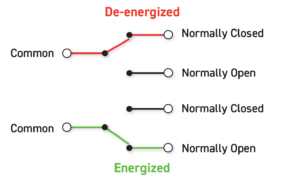Understanding Reed Relay Terminology
The relay industry has evolved with a set of its own nomenclature that describes the products available, however, not all of these terms are familiar to users. The following blog post seeks to describe and explain these relay terms.
Form A
Form A describes a relay whereby the contact is a simple switch, which is open or closed, and the un-energized position is the open condition. A single relay would also be described as a single-pole, single-throw (SPST) relay with a normally open (NO) contact. If the relay has multiple contacts in the same package it would be described as having (for example) 2 Form A contacts (DPST). Pickering has a range of Form A Reed Relays, for example, our Series 109 is an ideal choice for high-density applications or our high voltage Series 104 relays for up to 4kV.

Form B
Form B describes a relay whereby the contact is a simple switch, which is open or closed, and the un-energised position is closed. If you are interested in Form B relays Pickering has a range of catalogue parts, for example, our Series 107 Mini-SIL reed relays that feature the highest grade switches and are encapsulated in patented mu-metal can.
-
Shop our Mini-SIL Reed Relays – Pickering Series 107
-
More information on Pickering Series 107

Form C (Changeover – break before make)

Form D (Changeover – make before break)
Form D is a changeover relay designed to make contact with the second contact before releasing from the first contact. These relays are very rarely constructed from reed switches because of implementations issues
Latching Relay
Latching relays have two or more stable positions for the contacts when power is not applied. To change the state of a relay a coil has a voltage transiently applied to it with a defined duration. Latching relays can be used for applications where minimisation of control power (coil current) is critical or where a power failure requires the switch to be left in the state it was set to until power is restored. The latter case needs careful design to avoid transient change instructions as the power fails. The latching mechanism usually relies on a magnet to provide the latching function.
Latching relays are generally not liked in modern software-controlled systems because the software may not have direct knowledge of the relay state, particularly at power on. Some latching relays can have extra contacts to directly indicate the contact position. This type of relay is not commonly available in reed relay form.
Safety Relay
Also known as a force-guided contact relay this type of relay is designed with two or more contact sets (poles) and the mechanical design is such that if one contact one pole fails to change position because of a weld the other contact on another pole cannot close the corresponding contact. The mechanical design usually relies on forces being applied too close to the contacts. There are no commercial solutions for a safety relay using reed switches.
For more in-depth information about the wonders that are reed relays please see our Reed RelayMate page. This educational book provides an overview of how reed relays work, how they are constructed and how to interpret their specifications and make best use of them in their applications.








